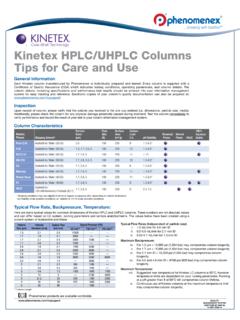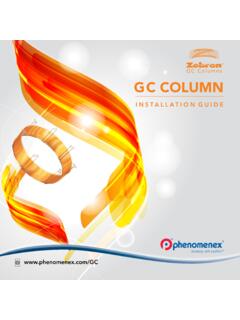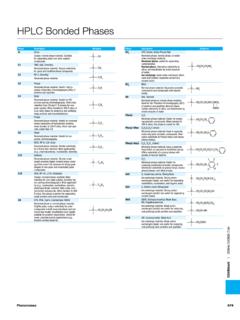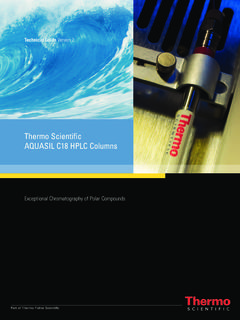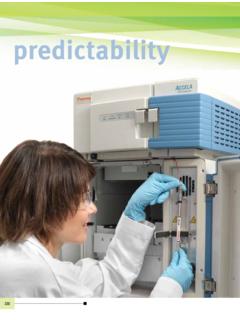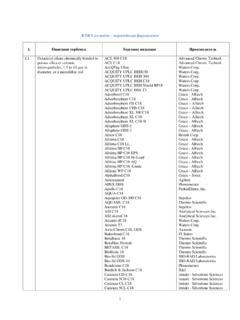Transcription of Core-Shell Technology Kinetex HPLC/UHPLC …
1 Kinetex HPLC/UHPLC Columns Tips for Care and UsePhenomenex products are available QUALITYMANAGEMENT SYSTEMCERTIFIED BY DNV GL9001:2008 Core-Shell TechnologyGeneral InformationEach Kinetex column manufactured by Phenomenex is individually prepared and tested. Every column is supplied with a Certificate of Quality Assurance (CQA) which indicates testing conditions, operating parameters, and column details. The column details, including specifications and performance test results should be entered into your information management system for easy tracking and reference. Electronic copies of your column s quality documentation can also be acquired at: receipt of column, please verify that the column you received is the one you ordered ( dimensions, particle size, media).
2 Additionally, please check the column for any physical damage potentially caused during shipment. Test the column immediately to verify performance and record the result of your test in your column information management Flow Rate, Backpressure, Temperature:Here are some typical values for common dimensions of Kinetex hplc and uhplc columns. These numbers are not absolute values and can differ based on LC system, running parameters and sample analytes/matrix. The values below have been created using a solvent system of Acetonitrile and PhasesShipping Solvent Particle Sizes ( m)Pore Size ( )Surface Area (m2/g)Carbon Load (%)pH StabilityReversed PhaseNormal PhaseHILIC 100% Aqueous StablePolar C18 Acetonitrile / Water (50:50) *C18 Acetonitrile / Water (50:50) , , , *EVO C18 Acetonitrile / Water (45:55) , , 5100200111-12XB-C18 Acetonitrile / Water (50:50) , , , *C8 Acetonitrile / Water (45:55) , , *BiphenylAcetonitrile / Water (45:55) , , *Phenyl-HexylAcetonitrile / Water (45:55) , , *F5 Acetonitrile / Water (40:60) , , *HILICA cetonitrile / 100 mM Ammonium Formate (93.)
3 7) , , Shipping conditions may vary slightly in terms of organic to aqueous ratio, depending on column dimensions. * pH stability under gradient conditions. pH stability is under isocratic CharacteristicsParticle Size ( m)Internal Diameter (mm)Typical Flow (mL/min)Typical Pressure (PSI)50 mm**150 mm**250 mm** 2600 5 1000 ** Column LengthTypical Flow Rates (Independent of particle size):i. mL/min for mm ID ii. mL/min for mm IDiii. mL/min for mm IDMaximum Backpressure:iv. For m > 15,000 psi (1,034 bar) may compromise column For m > 15,000 psi (1,034 bar) may compromise column For mm ID > 15,000 psi (1,034 bar) may compromise column For and mm ID > 8700 psi (600 bar) may compromise column longevityMaximum Temperature: viii.
4 Suggested max temperature for Kinetex LC columns is 60 C, however temperature limits are dependent on your running parameters. Running at a pH greater than 8 at 60 C will compromise column Continuous use of Kinetex columns at the maximum temperature limit may compromise column PhaseName:Reversed Phase 2 Test MixPart No.:AL0-3045 Contents:Uracil, Acetophenone, Toluene, NaphthaleneSolvent:Acetonitrile/Water (65:35 v/v)Detection:UV @ 254 nmInjection Vol.:Depends on dimensionsHILICName:HILIC Phase Test MixPart No.:AL0-8317 Contents:Toluene, Uracil, CytosineSolvent:Acetonitrile (containing toluene) / Water (85:15)Detection:UV @ 254 nmInjection Vol.:Depends on dimensions Mobile Phase CompatibilityWhen using any HPLC/UHPLC column, be sure to only use hplc grade solvents and materials while also avoiding immiscible solvent/buffer combina-tions.
5 Additionally, use of solvent filtration is highly recommended to remove trace impurities from your mobile phase of choice. The following Kinetex phases are stable in 100% aqueous conditions: Polar C18, EVO C18, Biphenyl, and F5. With all Kinetex columns please ensure that mobile phase pH does not exceed individual stationary phase limits. See chart in column characteristics section for individual Kinetex stationary phase pH InstallationInitial setup of your LC system is very important to ensure column performance:Ensure that your LC system is ready:1. Seals, lines, injector clean2. Lines primed (no dry lines or bubbles)3. Steady baseline4. Consistent pressures Flush LC system pump and line with mobile phase ( hplc grade and miscible with solvents that column is shipped in).
6 Mobile phase starting conditions check list: 1. Ensure that hplc grade mobile phase is well mixed, filtered, and degassed prior to use. 2. Ensure that column shipping solvent, remaining solvent in LC system, and mobile phase solvents are miscible. Set flow rate to mL/min (for mm ID) and install the column making sure that the arrow is in the direction of flow. Then increase the flow rate to mL/min ( ID) or mL/min ( mm ID) for 5-10 minutes. Collect solvent in a small flow and wipe outlet end of column to remove any particulates before connecting to detector. Install fitting/tubing into outlet end and run minimum 10 column volumes at low flow (~ mL/min) while monitoring the backpressure. 1. A steady pressure should indicate a constant flow while pressure fluctuation will indicate air in the Wide fluctuations in pressure may shock and damage the column so it s important to monitor the pressure.
7 Monitor pressure as well as signal from the detector, when both are steady, the column is ready for Column PerformanceWhen testing column performance, please use the manufacturer approved test CleaningReversed Phase: Clean with a gradient that is closest to the last solvent system on the system:For example, if the last injection ended with Buffer/Acetonitrile (75:25), it's more appropriate to start with 95:5 W ater/ Acetonitrile and then move step by step as needed to increase organic content ( 75:25 W ater/Acetonitrile 50:50 W ater/ Acetonitrile 5:95 W ater/Acetonitrile). For hydrophobic or oily materials, try flushing with Isopropy Alcohol (IPA), after the column has been flushed with Acetonitrile. When using IPA, ensure use of a low flow to prevent higher backpressures due to higher solvent viscosity.
8 For materials that are very hydrophobic, try Tetrahydrofuran (THF) instead. HILIC: To remove buffer, rinse with at least 10 column volumes of 95:5 Water/Acetonitrile. Repeat with 95:5 100 mM Ammonium Acetate (pH )/Acetonitrile. Then finish cleaning by flushing the column with 95:5 : When cleaning, set your flow rate lower than that of your method flow rate, especially when attempting to clean using methanol or IPA. Cleaning for a longer period of time is more often beneficial than adding more cycles. Working with very high amounts of THF is not recommended especially if system has PEEK tubing. Cleaning with THF is fine if the tubing are metal. Reverse flushing the column (against the direction of the arrow on the column) is fine, but please use low flow.
9 Here are suggested reverse flush flow rates based on column ID: mL/min ( mm ID) mL/min ( mm ID) mL/min ( mm ID)Column RegenerationReversed Phase Apply the same gradient flush as in the cleaning above, overnight at low flow. Reverse flushing is Phase For water removal, flush with:1. 30 mL 2,2 Dimethoxypropane and Glacial Acetic Acid in Then flush column with cleaning method from above, overnight at low flow rate. Column StorageIt is very important to make sure that your column is clean before storage. This includes removal of buffer, salts, sample, and ion-pairing agents. The recommended storage conditions are: Reversed phase: Acetonitrile/Water (65:35 v/v), Methanol can be used in place of acetonitrile. Normal phase: 100% Hexane or IPA HILIC: Acetonitrile/W ater (80:20 v/v) Please store with hplc grade or above solvents for Extending Column Lifetime Utilize sample preparation techniques such as solid phase extraction (Strata -X SPE products) or accessories (Phenex Syringe Filters) to minimize the injection of unwanted contaminants onto your system and column.
10 Use the correct guard column or guard cartridge system (SecurityGuard ) to help remove particulates before they foul your column. Do not overload your column. Inject suitable sample concentrations and volumes. Work in the appropriate separation mode for the column. Please see Column Characteristics chart for typical modes each stationary phase is used for. Store your column in appropriate solvent(s). Solvent switch correctly by slowly acclimating the phase from one miscible solvent to the other at a low flow: mL/min for mm ID and mL/min for mm WarrantiesPhenomenex hplc columns are warranted to meet the stated performance and quality and to be free of defects in material and workmanship. If you are unsatisfied for any reason, please give your Phenomenex Technical Representa-tive a call.

